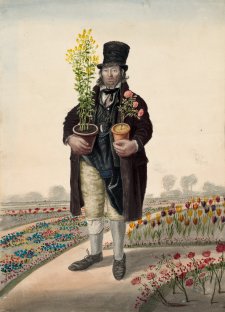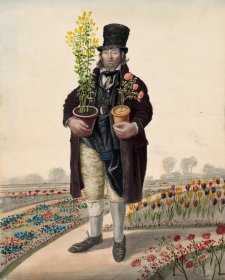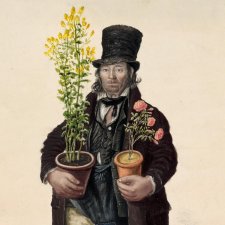- About us
- Support the Gallery
- Venue hire
- Publications
- Research library
- Organisation chart
- Employment
- Contact us
- Make a booking
- Onsite programs
- Online programs
- School visit information
- Learning resources
- Little Darlings
- Professional learning
With his bicorn hat, double-breasted scarlet coat and white knee breeches, all tricked out with gold braid, silver buttons, sash, ribbons and medals, ‘Whistling Billy’ of York is one of Dempsey’s most colourful and memorable portraits. It would appear, however, that the dark, ruddy-cheeked, moustachioed and almost handsome officer is not a serving soldier, but one of Dempsey’s usual cast of eccentric street people.
Only one substantial textual reference to this man has been found, a brief paragraph in the York Gazette from July 1830:
Whistling Billy. — Some person having taken it into his head, that his life was in danger from this well-known individual, the subject was brought under the notice of the Magistrates on Tuesday; and by their direction he was examined as to his state of mind by Dr. Wake, who gave it as his opinion, that it was not proper he should be at large; in consequence of which, he was ordered to be taken care of in the Lunatic Asylum.
From the tone of the article, it seems that the writer considers ‘some person’ has overreacted, and that Billy is quite inoffensive, despite his (broken and bandaged) sabre. Still, if he really was a lunatic, what might have been the nature of his illness? The military focus of his wardrobe suggests some connection to the Napoleonic Wars — perhaps he was a veteran, a youngish old soldier bearing psychic rather than physical wounds. The medals certainly look genuine. Then again, perhaps the costume is no more than a crazy show, possibly put together in excited response to the pomp and circumstance of the Duke of Wellington’s visit to York in September 1827.
In the 12-month period following Dr Wake’s examination, the admissions register of the York City Asylum mentions only two men from York of the right age to be identified with ‘Whistling Billy’. The first, William Richardson, does not seem to match the character profile. A shoemaker, Richardson was committed by his wife for ‘mania’ arising from an unspecified loss of property. He was discharged, cured, by his sister three weeks later. The other, more likely, candidate is Thomas Thompson who, described as a 34-year-old labourer, was sent to the asylum in May 1831 by the Overseers of the Poor, with a diagnosis of ‘imbecility’.
What is particularly intriguing about this entry is that the duration of the illness is given as 16 years, which places its start in 1815, the year of the Battle of Waterloo. This fact might confirm a diagnosis of post-traumatic stress disorder or, alternatively, might explain the Waterloo obsession as a focus point from the onset of psychosis.
If Thompson was indeed Whistling Billy, it is pleasing to note that his incarceration in the asylum was relatively brief. Thompson was declared ‘quite harmless’, and found accommodation at the workhouse in January 1833.
Collection: Tasmanian Museum and Art Gallery, presented by C. Docker, 1956



Dempsey’s people: a folio of British street portraits 1824–1844 is the first exhibition to showcase the compelling watercolour images of English street people made by the itinerant English painter John Dempsey throughout the first half of the nineteenth century.



Visit us, learn with us, support us or work with us! Here’s a range of information about planning your visit, our history and more!



We depend on your support to keep creating our programs, exhibitions, publications and building the amazing portrait collection!